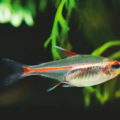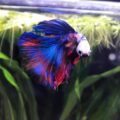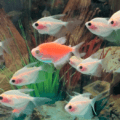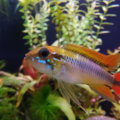Discover the beauty of Mikrogeophagus altispinosus, the Bolivian Ram! This guide offers essential tips for maintaining these vibrant dwarf cichlids in your aquarium.
If you are looking for something quick and easy to read or are a hobbyist or aquarist looking for a care guide for these fish, you have found the article. This guide is equipped with tips and relevant information to ensure you maintain the health of these beautiful Bolivian Ram fish.

Introducing the glorious Mikrogeophagus altispinosus care guide! These fish are affectionately known as the Bolivian Ram. This captivating beauty will delight any community tank and hobbyist.
These distinctly colorful and peaceful dwarf cichlids are perfect for aquarists of all levels and beginners, providing them with an enhanced and aesthetically pleasing aquarium. This dwarf cichlid overview will give you the necessary tools to understand this fascinating fish world and give you Bolivian Ram aquarium tips.
Exploring the Unique Features

The Mikrogeophagus altispinosus appearance is nothing short of exquisite fascination. Identifying Bolivian Rams is quite simple. If you find a fish with a glowing aura and hear angels singing, you are looking in the hot zone.
In all seriousness, these colorful dwarf cichlids sport a golden-yellow body, blue speckles, and vibrant red highlights. You would think these fish get a touch-up at the salon weekly. Their eccentric colorful pattern is hard to ignore in any tank and would simply add more elegance to what your tank already possesses.
- Color Pattern: Distinctive mix of yellow, blue, and red hues
- Adult size: Can grow up to 4 inches
- Unique Traits: Extended fins that help them gracefully navigate in the water and their calm demeanor that will bring tranquillity to their tankmates
Setting Up the Perfect Habitat

There is no perfect habitat until you create the ideal Mikrogeophagus altispinosus tank setup. By simply recreating their natural habitat, you will have a well-kept and happy fish. A bit of history of the Bolivian Ram is that they originated in Bolivia coming from small streams, large creeks, rivers, etc.
These fish are where aquatic environments that are always warm and soft with dense substrate in their surroundings. Additionally, they need shaded areas and places with crevices or large vegetation, so they can hide freely. Mimicking the natural habitat for Bolivian Rams can be achieved by following this guide.
- Tank Size and Layout: The freshwater aquarium for dwarf cichlids should be a minimum of 30 gallons for pairs or small groups
- Water Conditions: Soft water with a pH level of 6.0-7.5 and 75 degrees to 82 degrees Fahrenheit
- Substrate and Décor: Sandy substrate, driftwood, and robust live plant are ideal for this fish
Feeding Mikrogeophagus altispinosus: A Balanced Diet for Health
These fish are not strikingly stunning for nothing. Their maintenance requires a dedicated and balanced diet for cichlids rich in high-protein foods such as bloodworms, brine shrimp, daphnia, and quality pellets.
Because they are omnivores, they will also need plant-based foods that cover their nutritional gaps. Being consistent following the Bolivian Ram nutrition is not rocket science, it is fish science.
For more on feeding your aquatic pets check out The Ultimate Guide to Fish Food: Pros and Cons & Best Choices!
The feeding frequency is crucial. Feeding Mikrogeophagus altispinosus small portions multiple times a day will help to maintain their energy levels in the tank and enhance their coloration whilst avoiding overfeeding.
It is important to not overfeed your fish because whatever they do not eat, will be left in the tank to decompose and contaminate the tank with nitrate, which can be deadly to your fish.
How to Successfully Breed Mikrogeophagus altispinosus

Who would not want more of these graceful fish in their tank? There is a hack that has been used for centuries to have more of what you want. That is called breeding. Mikrogeophagus altispinosus can be perceived as an accomplishment due to its monogamous behavior and excellent parent care.
For successful Bolivian Ram spawning tips, cultivate a separate breeding setup with stable water parameters and suitable spawning sites like flat rocks or caves. The female will lay the eggs and the male will follow through with fertilizing them. You may find that the inexperienced fish pair consume their brood initially, however, they learn to care for their fry after a few attempts.
Raising dwarf cichlid fry involves feeding them microworms or baby shrimp to support their growth.
Finding the Right Tank Mates for Mikrogeophagus altispinosus

Selecting tank mates for Mikrogeophagus altispinosus requires choosing peaceful aquarium companions that match their temperament. Why is this so important? Because these Bolivian Ram fish do not thrive in stressful environments.
Compatible species include tetras, rasboras, and small catfish like Corydoras. The aggressive species on the blacklist for these fish are exodons, oscar, peacock bass, midas cichlid, and gray cichlid. This is not an exhaustive list, so you must do further research on the fish you want to be tankmates with your Bolivian Ram fish.
Another tip is to avoid overly active fish as they may cause stress with their quick and unpredictable movement in the tank.
Preventing Health Issues in Mikrogeophagus altispinosus
Everything mentioned in this guide so far does not hold any value if you cannot maintain the health of your Bolivian Ram fish. Some common issues your fish may face are stress, fin rot, and parasitic infections.
The best way preventing cichlid diseases from manifesting, is by having regular water changes and consistent key preventative measures. This can be having a diary for your fish which has a list of tasks to complete daily/weekly/monthly/yearly.
However, some things cannot be prevented, and this would require you to be observant and intuitive about your fish. Watch for signs of illness such as loss of appetite or faded color to address problems early on. Following these Mikrogeophagus altispinosus health tips will ensure you are eaten away with guilt for failing your fish.
Maximizing the Lifespan of Mikrogeophagus altispinosus

To maximize the lifespan of your Bolivian Rams is to focus on long-term care for Bolivian Rams by maintaining a clean environment and a balanced and nutrient-rich diet. Regular tank maintenance and health checks are integral components of this dwarf cichlid longevity guide.
These Mikrogeophagus altispinosus lifespan tips are simple and should be easy. If you have a desire to appreciate these fish and continue their vibrancy for as long as they can live, you will have many years ahead with them.
Conclusion
This complete Bolivian Ram guide emphasizes the spirited colors, peaceful temperament, and suitability of being Mikrogeophagus altispinosus tankmates. By mimicking their natural habitat and following these beginner-friendly cichlid tips, aquarists and hobbyists alike can enjoy the beauty and serenity these pleasant fish bring to any tank setting.










